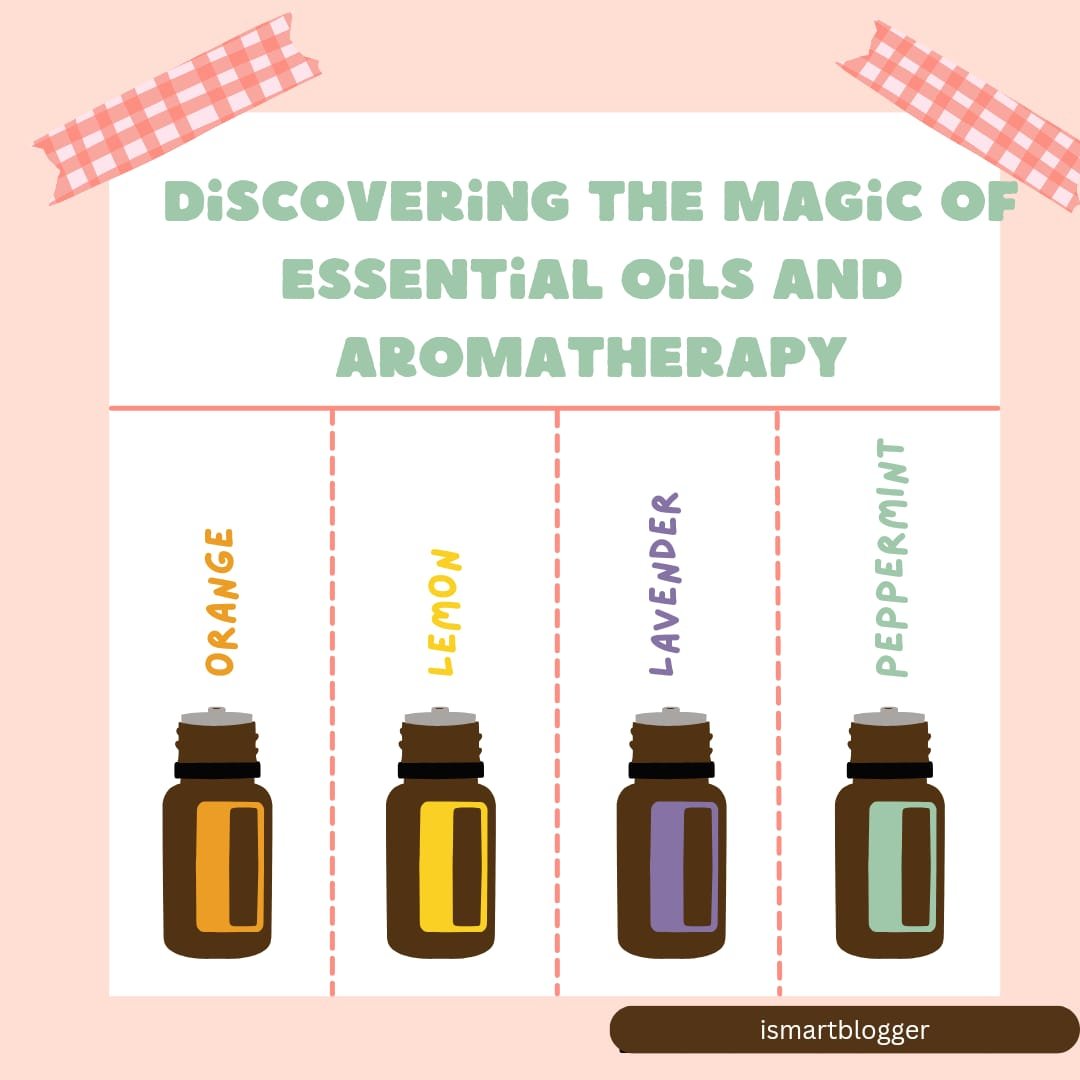Essential oils have been used for thousands of years for their therapeutic benefits and as a means of promoting overall wellness. Aromatherapy, which involves the use of essential oils to improve physical and emotional health, is a natural form of healing that has been gaining popularity in recent years. In this blog post, we will delve into the history and benefits of essential oils and aromatherapy, exploring the ways in which these natural remedies can improve our health and well-being.
I. Introduction
This introduction provides definitions and context for essential oils and aromatherapy. It also highlights the benefits of these natural remedies, giving us an idea of what to expect from the rest of the post.
A. Definition of essential oils and aromatherapy
– Essential oils are highly concentrated plant extracts that contain the natural fragrances and flavors of plants.
– Aromatherapy is the use of essential oils for their therapeutic benefits, both physically and mentally.
B. Brief history of the use of essential oils and aromatherapy
– Essential oils have been used for thousands of years for their medicinal and therapeutic properties, with evidence of their use dating back to ancient civilizations such as the Egyptians, Greeks, and Romans.
– Aromatherapy as a modern practice emerged in the early 20th century, when French chemist Rene-Maurice Gattefosse coined the term “aromatherapy” to describe the therapeutic use of essential oils.
C. Overview of the benefits of essential oils and aromatherapy
– Essential oils and aromatherapy have a wide range of benefits, including improved physical and mental health, reduced stress and anxiety, and improved sleep.
– Aromatherapy is also commonly used in healthcare settings to support healing, reduce pain, and improve outcomes.
II. History of Essential Oils and Aromatherapy
This section provides a brief history of the use of essential oils and aromatherapy, tracing the evolution of these natural remedies from ancient civilizations to the modern day. By outlining the history of essential oils and aromatherapy, this section helps us understand the roots of this practice and its continued popularity today.
A. Ancient civilizations and the use of essential oils
– Essential oils have been used for thousands of years for their medicinal and therapeutic properties, with evidence of their use dating back to ancient civilizations such as the Egyptians, Greeks, and Romans.
– Ancient civilizations used essential oils for a variety of purposes, including as perfumes, as ingredients in cosmetics and personal care products, and for their therapeutic properties.
B. Emergence of aromatherapy as a modern practice
– The modern practice of aromatherapy emerged in the early 20th century, when French chemist Rene-Maurice Gattefosse coined the term “aromatherapy” to describe the therapeutic use of essential oils.
– Gattefosse’s work was instrumental in popularizing the use of essential oils for their therapeutic properties, and in establishing aromatherapy as a legitimate practice.
C. Development of modern aromatherapy
– Over the years, the practice of aromatherapy has evolved and expanded, with more and more research being conducted on the therapeutic benefits of essential oils.
– Today, aromatherapy is a well-established practice, used by people all over the world for its many physical, mental, and emotional benefits.
III. Benefits of Essential Oils and Aromatherapy
This section provides a comprehensive overview of the various benefits of essential oils and aromatherapy. By outlining the physical, mental, emotional, and healthcare benefits of these natural remedies, this section gives us a clear picture of the many ways in which essential oils and aromatherapy can improve health and well-being.
A. Physical benefits: improved health and well-being, reduced stress and anxiety, improved sleep
– Essential oils can be used to improve physical health and well-being by promoting relaxation, reducing pain, and improving digestion.
– For example, lavender oil is commonly used to promote relaxation and improve sleep, while eucalyptus oil is often used to relieve pain and congestion.
B. Mental benefits: improved mood and cognitive function, reduced stress and anxiety
– Essential oils can also have mental and emotional benefits, such as improving mood and cognitive function, and reducing stress and anxiety.
– For example, bergamot oil is often used to improve mood and reduce feelings of stress and anxiety, while rosemary oil is commonly used to improve memory and cognitive function.
C. Emotional benefits: increased feelings of calm and relaxation, reduced feelings of stress and anxiety
– In addition to physical and mental benefits, essential oils and aromatherapy can also have emotional benefits, such as increasing feelings of calm and relaxation and reducing feelings of stress and anxiety.
– For example, chamomile oil is commonly used to reduce feelings of stress and anxiety, while ylang-ylang oil is often used to increase feelings of calm and relaxation.
D. Aromatherapy in healthcare: improved healing, reduced pain, and improved outcomes
– Aromatherapy is also commonly used in healthcare settings to support healing, reduce pain, and improve outcomes.
– For example, lavender oil has been shown to reduce pain and promote healing in post-operative patients, while peppermint oil has been shown to reduce pain and improve outcomes in patients with headaches.
IV. How to Use Essential Oils and Aromatherapy
This section provides a comprehensive overview of the various methods of using essential oils and aromatherapy, including inhalation and topical application. By outlining the various methods of use, this section helps us understand the different ways we can experience the benefits of essential oils and aromatherapy. Additionally, this section provides important safety information and precautions, reminding us to use essential oils responsibly and safely to avoid any potential risks.
A. Inhalation: diffusers, mist sprays, and steam inhalation
– Essential oils can be inhaled through various methods, including diffusers, mist sprays, and steam inhalation.
– Diffusers work by dispersing the essential oils into the air, allowing the user to breathe in the aromatic scents.
– Mist sprays and steam inhalation are also popular methods of inhalation, where the essential oils are mixed with water and inhaled through steam or sprayed into the air.
B. Topical application: massage, bath, and compresses
– Essential oils can also be applied topically to the skin through various methods, such as massage, baths, and compresses.
– When using essential oils topically, it’s important to dilute them in a carrier oil, such as coconut or olive oil, to prevent skin irritation.
– Topical application can be a highly effective way to experience the benefits of essential oils, as the oils can be absorbed through the skin into the bloodstream.
C. Safety precautions: potential risks and how to use essential oils safely
– It’s important to use essential oils safely and responsibly, as some oils can be toxic or cause skin irritation if used improperly.
– Some essential oils should be avoided during pregnancy, and some oils should not be used on children or pets.
– Before using essential oils, it’s important to research the specific oil being used, and to follow any safety precautions or guidelines for use.
V. Conclusion
This section provides a conclusion to the discussion of the history and benefits of essential oils and aromatherapy, summarizing the key points and providing some final thoughts and recommendations for using these natural remedies. By emphasizing the importance of seeking the advice of a healthcare professional, this section helps us make informed decisions about using essential oils and aromatherapy, and to ensure that we are using these remedies safely and effectively.
A. Summary of the history and benefits of essential oils and aromatherapy
– This section provides a summary of the history and benefits of essential oils and aromatherapy, highlighting the key points discussed in the previous sections.
– By summarizing the history and benefits of essential oils and aromatherapy, this section helps us understand the significance of this practice and why it continues to be popular today.
B. Final thoughts and recommendations for using essential oils and aromatherapy
– This section provides some final thoughts and recommendations for using essential oils and aromatherapy, including the importance of using essential oils responsibly and safely.
– Readers may also find it helpful to learn about different essential oils and their specific benefits, as well as to experiment with different methods of use to find what works best for them.
C. Encouragement to seek the advice of a healthcare professional before starting any new natural remedies
– While essential oils and aromatherapy are generally considered safe and effective, it’s always a good idea to seek the advice of a healthcare professional before starting any new natural remedies.
– This section encourages us to talk to their doctor or other healthcare professional to ensure that using essential oils and aromatherapy is safe and appropriate for their individual needs.
“Ready to bring the power of scent into your life? Start incorporating essential oils and aromatherapy into your daily routine and discover the benefits for yourself! So why wait? Experience the magic of essential oils and aromatherapy today and start feeling the benefits for yourself! Unlock the full potential of essential oils and aromatherapy for a better you. by visiting the link for Aromatherapy First Aid Kit





